A few days before Transport Scotland’s latest plans for the Rest and Be Thankful were launched (see here), Fergus Ewing MSP was in the news calling for the dualling of the A9 to be speeded up. Just as with the proposals for the A83, there was no mention of the fact a significant part of the A9 lies within a National Park or the implications of that.
Fergus Ewing’s arguments about dualling the A9
The Scottish Government committed to dualling the A9 in December 2011 and to complete the work by 2025 (see here). Mr Ewing blames the Bute House deal, signed between the SNP and Greens in August 2021, for the delays. That is not credible. The agreement stated “work on other trunk roads projects and programmes under construction, design, development or procurement [part from the A96] will continue and be subject to the normal statutory assessment and business case processes” . It has also only been in existence two years, compared to the eleven and a half years for the A9 dualling project, during which time the Scottish Government has invested £430m out of a projected budget of £3bn (2008 prices). This shows the project was well behind schedule whatever influence the Greens may have had.
Mr Ewing also used the recent spate of deaths on the A9 to claim that the dualling delays was costing lives. There were 13 deaths on the Perth to Inverness section last year, 12 of which were on the single carriage sections. The long-term statistics, however, show (see here) that whatever the safety benefits of dual carriageways, this cannot be more than part of the explanation:
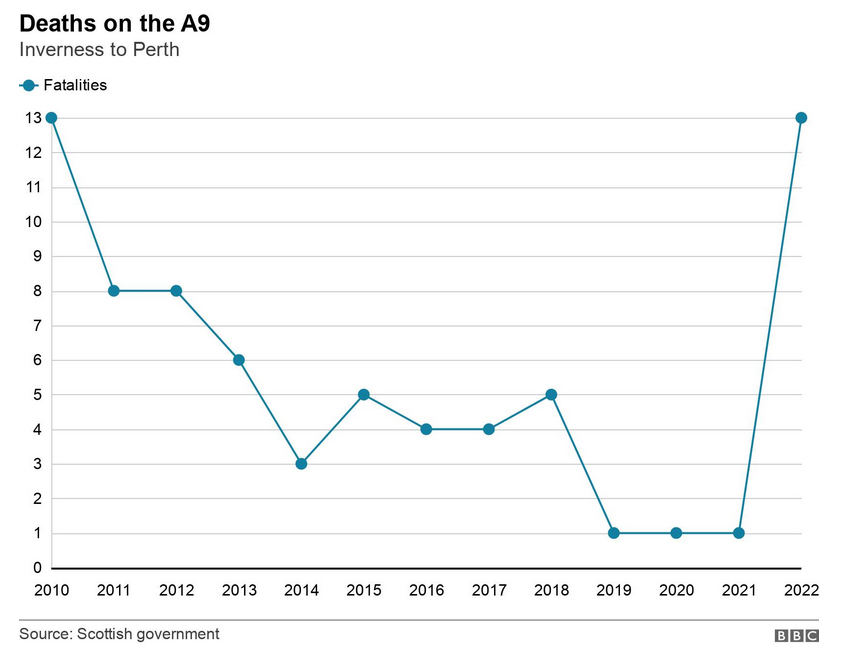
2014 was the year average speed cameras were introduced and for a time it appears they had a significant impact. So, what has caused the death rates – every one is a tragedy – to go up again?
In calling on the Scottish Government to speed up the dualling of the A9 both Mr Ewing and Kate Forbes MSP, who supported him, failed to say anything about the Highland Mainline Railway, much of which is still SINGLE TRACK. This affect both the frequency of the service (hourly after after upgrades in 2019 and the length of time the train journey takes (see here)).

Unlike the A9, the proposals for electrifying the Highland Main Line which is in many respects in a worse state than it was in the 19th century do not even have a date (see here). A fully dualled and electrified line would enable a far better train service and help to reduce the number of vehicles on the A9, something that Mr Ewing never mentions.
The A9 and the Cairngorms National Park
The Cairngorms National Park Authority (CNPA)’s National Park Partnership Plan (NPPP) 2022-27 was underpinned by a series of fact sheets (a welcome contrast to the Loch Lomond and Trossachs National Park Authority’s draft NPPP which is currently out for consultation and is mostly based on thin air (see here)). The CNPA’s fact sheets included one on transport which started as follows:

This point raises the important question of what should be given greater priority, fixing the problems of the A83 through the Rest and Be Thankful and the A82 along Loch Lomond, for example, or dualling the A9? Perhaps Kate Forbes, who represents Lochaber as well as Speyside, could say which she believes is more important?
The fact sheet also included interesting information about particulate emissions from vehicles:
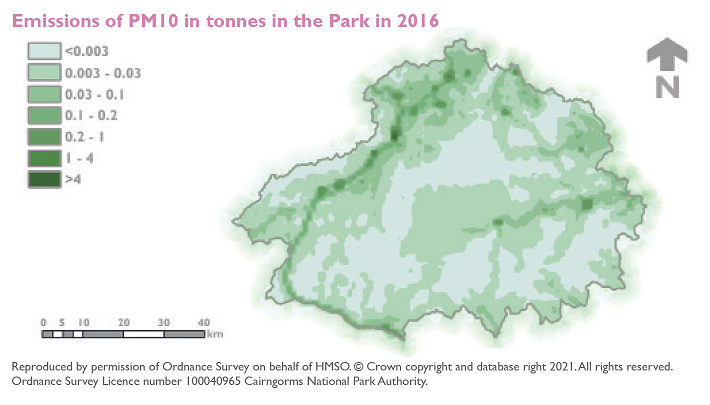
The emissions in the National, while well below levels in Scottish cities, are highest along the A9. Dualling it so average vehicle speed and fuel consumption rises can only make the problem worse. Those who believe that electric vehicles will address this problem need to be able to explain how many electric vehicles will be using the A9 in fifteen years time? As a result of the cost of electric cars and the shortage of rare metals required for battery use, it is likely that traffic will drop significantly in the next two decades. That means investment in dualling yet more roads is likely to be a waste of money long-term.
The CNPA recognised in its NPPP that private car use would reduce in future:
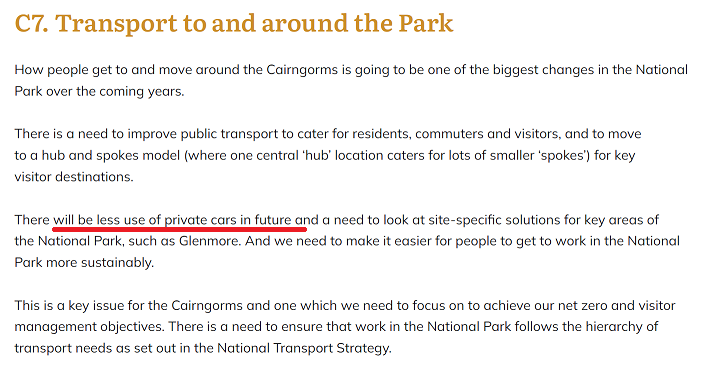
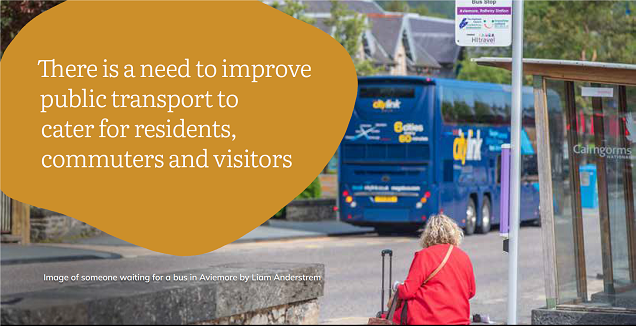
Unfortunately, it mainly focused on behaviour change rather than investment as a means of enabling this shift:
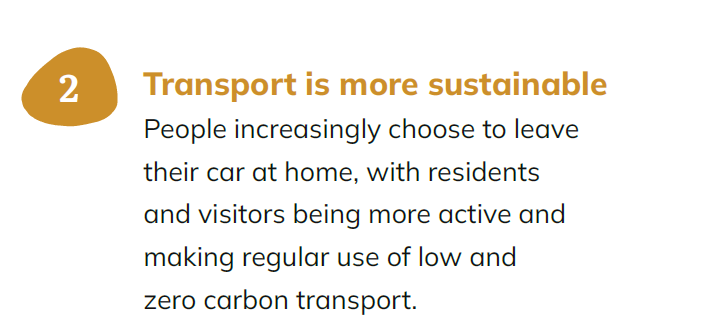
And it copped out on the dualling of the A9, no doubt to avoid falling into a political hornet’s nest, despite what was recommended in the Environmental Impact Assessment that preceded the NPPP:

Instead of stating that any further dualling of the A9 through the Cairngorms National Park should consider all of its statutory aims, policy C1 of the NPPP lends support to improvements in both the roads and the rail network:
“Supporting sensitively-designed improvements to the A9 and other trunk roads and the main railway
line as an integral part of enhancing the connectivity of the Highlands.
This policy avoids saying which is the more important:
Policy C3 re-iterates the landscape point, “Ensuring road upgrades and improvements respond to local landscape character”, but says nothing about the likely impact on the CNPA’s other objectives. . For example, if the A9 dualling goes ahead it will blow the CNPA’s targets for reaching net zero out of the water.
The targets for transport in the NPPP are not fit for purpose:

What climate emergency if in 22 years time just a quarter of visitors to the Cairngorms National Park are expected to arrive by public transport? There is a yawning gap between the objectives set out in the plan and the spin:
“Meeting the objectives within this Partnership Plan will mean hard choices need to be made. There are ambitious targets to increase the number of affordable houses, improve active travel and public transport, reduce deer numbers ……………This is not tinkering around the edges, this is fundamental change that we need to see and support.”
What needs to happen with the A9 dualling project?
Given the climate emergency and that private car use will have to reduce in future, ditching the A9 dualling project shouldn’t be a hard choice but instead, under pressure from Mr Ewing, the Scottish Government has committed to announce an update on how it is progressing its current plans in the Autumn. As long as the Scottish Government, including the Greens, remain on the defensive and fails either to make the arguments about where the priorities for road improvements should lie Scotland-wide or promote an alternative vision for public transport along the A9 corridor, they are likely to remain on a hiding to nothing.
It is clear some road improvements are needed across Scotland, including sections of the A9 north of Inverness and at some of the road junctions between Inverness and Perth. However, because of the climate emergency, we need a modal shift to public transport and to find alternative solutions to dual carriageways as a means of reducing the carnage caused by cars. A National Park worth its name should be able to say simply and openly that the A9 dualling project needs to be dropped and counteract the misinformation being put out by the likes of Mr Ewing.
A positive vision would put upgrading the Highland Mainline, from single to dual track and from diesel to electric, at the heart of future investment. The Scottish Government should be aiming for a minimum train service of once every half hour between Perth and Inverness supplemented by a 15 minute local shuttle service through Speyside, from Dalwhinnie to Carrbridge, with connecting electric buses to Cairn Gorm and places like Laggan. Such a service would enable the majority of visitors to Speyside to arrive and enjoy the area by public transport by 2045 and help many local residents of the National Park to leave their cars at home. Why do those in power appear to incapable of developing such a vision?

There is not an hourly train service on the highland main line. The current Scottish Government have included it as target for the last 12 years but have yet to achieve it.
Thanks for the clarification which adds to the argument about the neglect of rail, Nick
Most of the increase in deaths last year can be attributed to American tourists.
As an example, the family of 3 killed at Ralia, wrong way into a lorry.
The Scots Grandparents and their 2 year old Grandchild killed at Slochd, American driver charged.
There were numerous others, B+B owners and Tourist Office staff reported American tourists who arrived on the ‘Red Eye’ overnight flights into the Central Belt, picked up a hire car, then proceeded to drive to Inverness to see some ‘Outlander’ or other such film setting.
Some had no idea of speed limits, and some complained about ‘having’ to drive on the wrong side of the road….
There were deaths on other Scottish roads for exactly the same reason.
The removal of foreign travel for American Citizens after the Pandemic, along with the weak £, was a recipe for a surge in tourists.
As a motorist who has driven cars and commercial vehicles on the A9 for 40+ years, another issue is the 50mph signage for the lorry trial, which sort of ended without a conclusion.
With modern cars now picking up speed limits from signage, there has been an increase in people doing 50mph on single carriageway sections.
This then creates a crocodile behind them, so when overtaking opportunities appear, there is a rush to get past.
Unfortunately, there also seems to have been an increase in those driving at 50mph, who, when approaching a dualled section, then accelerate to 80mph, I’m not sure if these are Americans, it certainly seems like newer cars who do this, then back to 50mph on the single carriageway.
Over a distance, frustration can build with this behaviour, that’s when risks get taken.
Another result of the Average Speed Cameras is cars randomly sharply braking as they approach a camera gantry, I’ve seen a few near misses because of this.
There is virtually no Traffic Policing on the A9 compared with pre average speed camera days, all in the interests of ‘efficiency’.
The level of litter, and overgrown signage, worn safety lining and potholes on the A9 is shocking.
If traffic flowed smoothly, without accelerating and braking , emissions would also reduce.
There are specific junctions which need improved, The House of Bruar appears to attract people who turn right across traffic without looking, or, travelling in convoy, head South and force themselves onto the A9.
Having witnessed the aftermath of a motorcycle fatality because ‘Doris’ didn’t look before turning into the A9, I have no wish to see that awful sight again.
Dualling certainly isn’t a panacea, but when we have Politicians totally uninterested in the Highlands, nothing will get done, and people will keep dying…
The fact that there are drivers from other nations right around the world on the highways and byways of Scotland is a cause for extra fatalities, no one denies this. The instinct any driver develops when suddenly confronted by an obstacle in the centre of any carriageway ahead, is to turn towards the nearside verge ..(when in their home land) For drivers from EU and North American nations (the majority of visitors on holiday) this can have fatal consequences when using British roads. But the real reason for accidents on the A9 is far far simpler than that. It appears to have escaped the notice of all politicians who decide these things that Modern emission regulation compliant HGV are well able to maintain a speed in excess of 55 mph. (90kph) uphill and downhill all day long 24/7 (only restricted by driver hours and local regulation). Superbly efficient and quiet engines are today managed by software for maximum efficiency. Many will use automated gearboxes which self select gearing. These new HGV will also out-brake most cars, even fully loaded particularly if the car driver is idling along happily ‘mind in neutral’ while on holiday. Many modern HGV can be fitted as standard, with automated sensor-activated braking systems. When the speed limit for trucks was raised some years ago from 40 to 50 mph along the A 9 single carriageway sections, accident rat s were seen to drop. Unfortunately for statisticians- and public opinion about HGV this speed relaxation also coincided with the introduction of the hugely costly CCTV gantries and average speed camera systems. So the real benefit of raising HGV speed limits will never be fully quantifiable …by anyone ….ever . Yet it can be argued that if the trunk road delivery trucks were actually legally able to travel at the same identical limit of speed as cars along the single lane sections of the A9 , with only cars …NEVER small delivery vans or Camper vans ….able to use dualled sections to travel at 70…then bunching in long tail-backs frustrated behind ‘large shapes’ would never be caused by them. This point worth reminding those who decide these things in Scotland. In the Netherlands the speed limit outside built up areas all across the whole nation is 80 kph ( 50mph) It is very strictly enforced by HIDDEN use of both mobile and fixed cameras. Not guys decked out in flourescent jackets “shouting” look at me !” and everyone suddenly slows down. ) On designated “AutoSnelwegen” (Motorways/autobahns ) the max limit is higher 130 kph, but only during certain night-time hours. During the day the national limit is usually 100 kph.( 62mph.) Any local effective lower limit along any stretch of main highway also in Germany, is individually flagged by permanent fixed signs affixed to the crash barriers at regular intervals. Further restrictions are automated thanks to overhead gantries where flows are monitored to prevent bunching and temporary lower limits reset on Matrix panels.) The penalty fine system for infringement is fully automated and the charges really hurt ! Not like the A9 where gantries may not actualy function properly for days/weeks , and you seldom see any police patrol now, except during some serious incident when of a sudden you may see huge numbers ,who then stop other vehicles from actually moving on for many, many hours. There is much global professional transport knowledge within the nation’s industry from which Transport Scotland might actually learn..
Electrification of the Highland mainline would cost massively more than using hydrogen powered trains and have a far higher carbon cost. ScotRail already has one hydrogen train on trial, this is the way forward.
Hi John, you are absolutely right and I should have thought of this. Funnily enough I tried locally in Glasgow where they are electrifying line to E.Kilbride at vast expense (the electric lines require road bridges to be raised etc) to raise the question about hydrogen but got nowhere. Hydrogen is as I understand it is generally a tricky fuel to make work – due to difficulties compressing it – but not for trains. Moreover, since trains are far safer than cars, its easier to mitigate the risks. Nick
Of course duelling the A9 would benefit public and shared transport, and HGVs, as well as private cars. The need for improvement is not “rail vs road” but “rail and road”. So we should certainly be discussing why the rail infrastructure is not being upgraded. The Scottish Greens have called for the Highland Mainline to be upgraded for some time – but clearly there’s only so much they can negotiate as the junior partner in government. The Highland Mainline is owned and run by Network Rail – who’s multi-£bn upgrade programme has seen only £57m spent on this in recent years. Network Rail is managed by the UK Gov via the UK Dept for Transport. The problem is that Scotland’s priorities aren’t getting due consideration in Westminster… neither Labour nor the Tories have identified this as a priority.